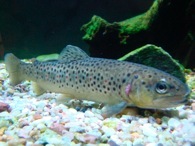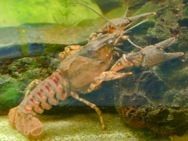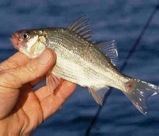When it comes to fishing, no animal does it better than
Gavia immer. This sleek and quick bird is able to sink under the water without even creating a ripple. As stated earlier the loon uses its webbed feet to thrust them down into the water. What else helps
Gavia immer be efficient at fishing, what types of prey do they consume, how do loons feed their chicks, and how much do they eat? All of these questions are answered and outlined below!
Not only do a loons large webbed feet help them while fishing, but also their blood red eye. These beautiful spheres situated on either side of the head reflect the red and orange light, making them red in appearance. The colors of light absorbed by water are the blue and green ends of the light spectrum. Because loons dive so deep to retrieve their dinner they need to be able to see under faint light conditions.
If the color of the loons eye was anything but red, all colors like blue and green would be undetected and they would not be able to see in the depths of the lake. Blind fishing would prove to be an ineffective way of acquiring nutrients! Because of the unique ability to see underwater in such deep depths, loons fish using sight alone. They track the prey and usually swallow the prey whole under the water. Though they can see in areas of relatively low light,
Gavia immer does not feed at night. The speed of the loon also aids in nutrient acquisition. Loons must able to out swim the prey because they only feed on live organisms.
Gavia immer have a very diverse pallet. As mentioned under the
Adaptation page of this site, trout are the meal of choice for the common loon. If they live on trout lakes they will eat trout, otherwise they alter their diet and consume other tasty treats instead. Loons enjoy prey such as, crayfish, frogs, perch, leeches, minnows,
salamanders and other varieties of fish such as walleye and northern pike.
They are able to eat such large fish because of they have an elastic esophagus. Usually smaller prey items are selected over large ones. If there are no fish available they resort to eating
mollusks, insects and even green algae or other aquatic vegetation. Baby loons often eat algae and other vegetation as their source of nutrients until they learn to dive.
In the early stages of life young loons require a lot of parental care. According to
Loon Magic, loon parents feed their chicks up to seventy-three times a day! Much of the food consumed in the first couple weeks of life is some sort of plant material. Chicks scavenge for fish early but often have a hard time catching any. The parent loon teaches the chick how to fish by placing an injured fish in front of the baby. Chicks require the help of a parent for the first two weeks and slowly become more independent.
In a study conducted by
Evelyn H. Merrill on chick consumption, she found that eight week old chicks consumed about 7.38 grams per hour of prey like yellow perch, blue gill and minnows.
Gavia immer contain a very large appetite and a hefty food requirement. The average loon weighs about seven to nine pounds (7-9 lbs.). Because the loon is such a large bird it requires a lot of nutrients. During the nesting period up to a ton (2,310 lbs.) of fish can be consumed by two adult loons and their chicks in a 15 week period. This isn’t surprising however. Loons require a lot of energy to maintain body temperature, acquire nutrients and fly. A single loon can eat eight dozen minnows in one day!
Loons eat nearly all day long and then rest from their fishing adventures at night. We now know how much and what they eat. Now we can look at Reproduction and chick-rearing.







